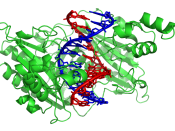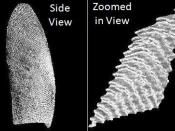Biotechnology is a fast growing area. Gene manipulation is a huge part of Biotechnology. Every human being has a unique DNA fingerprint. Regular fingerprints on fingers are not as reliable as they once were. Conventional fingerprints are easily altered by surgery. However, a DNA fingerprint is formed to be the same for every part of the human body. It cannot be changed by surgery. Because of this, DNA fingerprinting is rapidly growing to become the ideal way to identify and distinguish among human beings (http://esg-www.mit.edu:8001/esgbio/rdna/fingerprint.html).
The gene manipulation that occurs in getting the fingerprint can be done in six steps. The first step is to isolate the DNA. The DNA must be obtained from the cells or tissues of the body for example: blood, hair or skin is effective. The second step is to use restriction enzymes to cut the DNA. The DNA pieces are sorted according to size by using electrophoresis.
The DNA is then passed through a gel substance. In the third step, the DNA pieces are transferred to a nylon sheet. In steps four and five, radioactive or colored probes are added to the sheet, which produces a pattern called the DNA fingerprint. During the sixth step is where the DNA fingerprint is actually formed. It is built by using several probes simultaneously (http://esg-www.mit.edu:8001/esgbio/rdna/fingerprint.html).
There are many positive aspects of DNA fingerprinting. It can be used to diagnose inherited disorders in prenatal and newborn babies. Early detection can help to prepare for the disorder. Another pro is the studying of the DNA fingerprint can identify DNA patterns associated with the disease. This information can help in the cure. Also, FBI and police can use DNA fingerprints to identify possible suspects. DNA fingerprints are much more fool proof than hand fingerprints. It can also be used to match...



Good Essay
GREAT ESSAY DUDE!
0 out of 0 people found this comment useful.